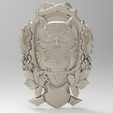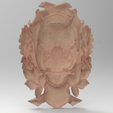Owls are birds from the order Strigiformes, which includes about 200 species of mostly solitary and nocturnal birds of prey typified by an upright stance, a large, broad head, binocular vision, binaural hearing, sharp talons, and feathers adapted for silent flight. Exceptions include the diurnal northern hawk-owl and the gregarious burrowing owl.
Owls hunt mostly small mammals, insects, and other birds, although a few species specialize in hunting fish. They are found in all regions of the Earth except polar ice caps and some remote islands.
Owls are divided into two families: the true (or typical) owl family, Strigidae, and the barn-owl family, Tytonidae.
Contents
1 Anatomy
1.1 Sexual dimorphism
1.2 Adaptations for hunting
1.2.1 Flight and feathers
1.2.2 Vision
1.2.3 Hearing
1.2.4 Talons
1.2.5 Beak
1.2.6 Camouflage
2 Behavior
2.1 Breeding and reproduction
3 Evolution and systematics
3.1 Ogygoptyngidae
3.2 Protostrigidae
3.3 Sophiornithidae
3.4 The family Tytonidae: barn-owls
3.5 The family Strigidae: Typical owls or True owl
4 Symbolism and mythology
4.1 African cultures
4.2 Asia
4.3 Ancient European and modern Western culture
4.4 Hinduism
4.5 Native American cultures
5 Rodent control
6 Attacks on humans
7 Conservation issues
8 References
9 Further reading
10 External links
Anatomy
Burrowing owl (Athene cunicularia)
Captive short-eared owl chick at about 18 days old
Owls possess large, forward-facing eyes and ear-holes, a hawk-like beak, a flat face, and usually a conspicuous circle of feathers, a facial disc, around each eye. The feathers making up this disc can be adjusted to sharply focus sounds from varying distances onto the owls' asymmetrically placed ear cavities. Most birds of prey have eyes on the sides of their heads, but the stereoscopic nature of the owl's forward-facing eyes permits the greater sense of depth perception necessary for low-light hunting. Although owls have binocular vision, their large eyes are fixed in their sockets—as are those of most other birds—so they must turn their entire heads to change views. As owls are farsighted, they are unable to clearly see anything within a few centimeters of their eyes. Caught prey can be felt by owls with the use of filoplumes—hairlike feathers on the beak and feet that act as "feelers". Their far vision, particularly in low light, is exceptionally good.
Owls can rotate their heads and necks as much as 270°. Owls have 14 neck vertebrae compared to seven in humans, which makes their necks more flexible. They also have adaptations to their circulatory systems, permitting rotation without cutting off blood to the brain: the foramina in their vertebrae through which the vertebral arteries pass are about 10 times the diameter of the artery, instead of about the same size as the artery as in humans; the vertebral arteries enter the cervical vertebrae higher than in other birds, giving the vessels some slack, and the carotid arteries unite in a very large anastomosis or junction, the largest of any bird's, preventing blood supply from being cut off while they rotate their necks. Other anastomoses between the carotid and vertebral arteries support this effect.[1][2]
The smallest owl—weighing as little as 31 g (1 oz) and measuring some 13.5 cm (5 in)—is the elf owl (Micrathene whitneyi).[3] Around the same diminutive length, although slightly heavier, are the lesser known long-whiskered owlet (Xenoglaux loweryi) and Tamaulipas pygmy owl (Glaucidium sanchezi).[3] The largest owls are two similarly sized eagle owls; the Eurasian eagle-owl (Bubo bubo) and Blakiston's fish owl (Bubo blakistoni). The largest females of these species are 71 cm (28 in) long, have 54 cm (21 in) long wings, and weigh 4.2 kg (9.3 lb).[3][4][5][6][7]
Different species of owls produce different sounds; this distribution of calls aids owls in finding mates or announcing their presence to potential competitors, and also aids ornithologists and birders in locating these birds and distinguishing species. As noted above, their facial discs help owls to funnel the sound of prey to their ears. In many species, these discs are placed asymmetrically, for better directional location.
Owl plumage is generally cryptic, although several species have facial and head markings, including face masks, ear tufts, and brightly coloured irises. These markings are generally more common in species inhabiting open habitats, and are thought to be used in signaling with other owls in low-light conditions.[8]
Sexual dimorphism
Sexual dimorphism is a physical difference between males and females of a species. Reverse sexual dimorphism, when females are larger than males, has been observed across multiple owl species.[9] The degree of size dimorphism varies across multiple populations and species, and is measured through various traits, such as wing span and body mass.[9] Overall, female owls tend to be slightly larger than males. The exact explanation for this development in owls is unknown. However, several theories explain the development of sexual dimorphism in owls.
One theory suggests that selection has led males to be smaller because it allows them to be efficient foragers. The ability to obtain more food is advantageous during breeding season. In some species, female owls stay at their nest with their eggs while it is the responsibility of the male to bring back food to the nest.[10] However, if food is scarce, the male first feeds himself before feeding the female.[11] Small birds, which are agile, are an important source of food for owls. Male burrowing owls have been observed to have longer wing chords than females, despite being smaller than females.[11] Furthermore, owls have been observed to be roughly the same size as their prey.[11] This has also been observed in other predatory birds,[10] which suggests that owls with smaller bodies and long wing chords have been selected for because of the increased agility and speed that allows them to catch their prey.[citation needed]
Another popular theory suggests that females have not been selected to be smaller like male owls because of their sexual roles. In many species, female owls may not leave the nest. Therefore, females may have a larger mass to allow them to go for a longer period of time without starving. For example, one hypothesized sexual role is that larger females are more capable of dismembering prey and feeding it to their young, hence female owls are larger than their male counterparts.[9]
A different theory suggests that the size difference between male and females is due to sexual selection: since large females can choose their mate and may violently reject a male's sexual advances, smaller male owls that have the ability to escape unreceptive females are more likely to have been selected.[11]

/https://fbi.cults3d.com/uploaders/14219689/illustration-file/282b1f5e-2792-4020-9612-63674b383292/Owl_Shield.png)





